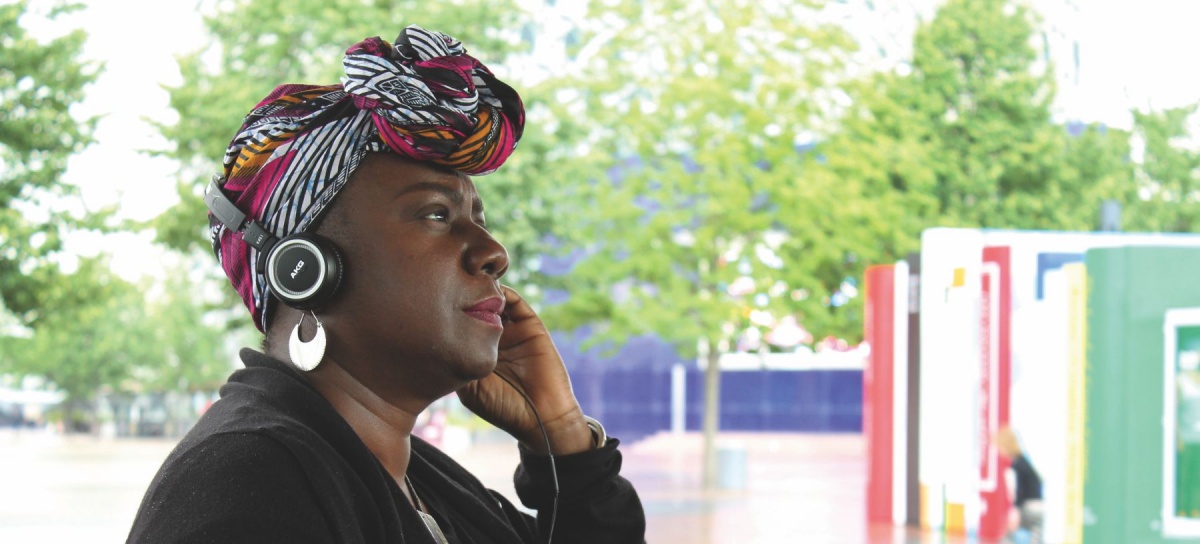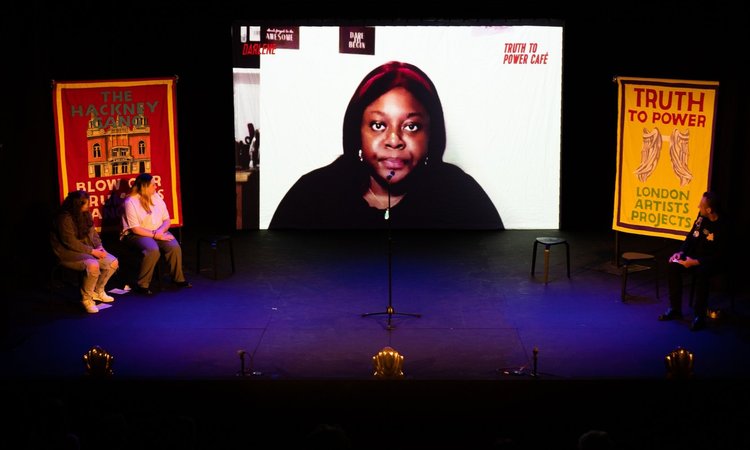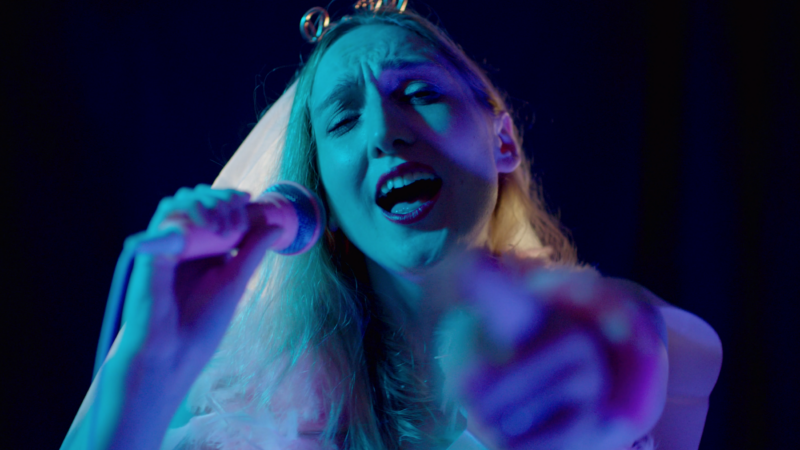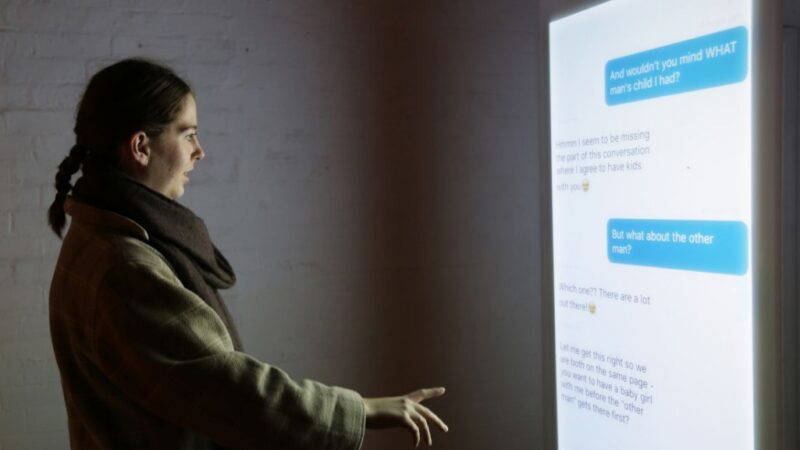How can a travelling arts installation in the UK become an award-winning podcast with a global audience? This case study explains how a small team at the cfound a digital way to get their message and stories into their first-ever podcast series.
What’s it about?
The Empathy Museum is a constantly travelling arts installation based in a freight container that has been converted into an enormous shoe box. When you enter the box, you get to pick a pair of shoes that you then wear as you listen to their owner’s story over headphones.
The original owner of the shoes could be a florist or a driving instructor, a sex worker or a Syrian refugee. It’s an intensely personal experience to walk around with someone’s voice in your head and their shoes on your feet. The intention is give a visceral connection between the listener and the person, it’s about having our perspective changed by understanding someone else’s world.
The work is called A Mile in My Shoes and, alongside other Empathy Museum exhibits, was created by Clare Patey, with a team including executive producer Rachel Briscoe. After the Museum had been travelling for some time and they had a growing archive of audio stories, the Empathy Museum decided to look into podcasting.
With the help of The Space, the result is the podcast A Mile in My Shoes, which brings you these stories every week.
“It’s always first-person audio,” explains Rachel Briscoe. “This is my experience, this is what happened to me, this is how I see the world. One of my favourite ones, for example, is Gary, who works in the sewers in London, and he loves his job so much. I would never have really thought of that and certainly not have thought it would be a job that anyone would like to do. So there’s a combination of dramatic ones and ones where you’d go gosh, I’d never have thought of it like that.”
Gary gave his sewer waders to the project. A woman named Sian donated the boots she wears when she works in a lifeboat. “Then a man in Scotland called Brodie told us about how he got electrocuted, and it was only because he was wearing crocs that he survived,” says Briscoe. “So he was, like, I have to give these crocs.”
Consequently, before the Empathy Museum even thought of doing a podcast, it was amassing a lot of great audio material. That’s very different to most podcasts which start with nothing, and Briscoe says this meant that taking on the whole extra task of producing a series was comparatively simple.
“It’s very easy what we’ve done,” she says. “It’s much easier than generating something from scratch and it doesn’t take that much more time.”
Solving technical challenges
Having an archive of material to mine and an existing successful arts project to draw from is an amazing opportunity to make more of your work and reach more people. However, recording audio for a travelling exhibition is different to doing it for a podcast.
Some of those differences are subtle, such as the way that some stories seem to work better as podcast episodes than others. “About a quarter of them end up as podcasts,” explains Briscoe.
“We’ve collected over 300 stories and we’ve put up 62 podcasts. We think we’ve only got another 20 at the moment that we would put out as podcasts, but because the Empathy Museum is always going out as a physical entity, we’re always collecting new stories. We just have to keep ahead of ourselves.”
There are also practical problems, such as the fact that when you listen to the podcast version of the exhibition, you can’t wear the shoes.
“What we’ve started doing now is to get the person to describe their own shoes so that we have that moment of audio,” says Briscoe. “For all the ones where we didn’t have that, we got people in and went ‘can you open the box and describe the shoes that are in there?’”
She says that making the podcast “has informed how we’re collecting stories,” but also that it’s almost as if they now have two distinct projects.
“How do you translate a live experience, how do you translate that sensory thing of wearing the shoes?” she says. “I don’t think we have, really. And I think there was a moment when we went, do you know what? It’s not going to be same. It is a different thing.”
It’s also a different thing for the contributors whose stories become podcast episodes. The Empathy Museum made certain that it had the permission of the contributors to use their stories, but it would have been easy not to and especially so since the podcast was not part of the original plan.
The team’s experience meant they had already known to always ask for permission to use material for more than the original scope of the project, but the team’s experience also meant that they know when this isn’t enough.
Fittingly for a project called the Empathy Museum, the team was conscious of just what it really meant having your story told to a wider audience. Despite having all of the rights, despite having the signed permission of every participant, Briscoe is adamant that you still have a duty of care to the contributors and to carefully consider what stories you’re sharing.
“People sign pieces of paper without really reading it,” she explains, “and if you’re a hard-nosed company you don’t care, but we would always want to be able to look the person in the eye. If you know they would be really unhappy, you just can’t use it.”

The approach
Arts organisations have that sensitivity and awareness of their audiences, but they also have much more relevant digital experience than they might imagine.
“If you’re an arts organisation from a non-digital background, you can think that you don’t know anything about podcasting or marketing projects like this,” says Briscoe. “But it’s exactly the same way as you sell tickets. You know how to talk about your work, you have a mailing list. As an arts organisation, you do all of the same things as you would to market a festival or a show.”
Although the A Mile in My Shoes podcast is a digital project, it is entwined with the physical one that travels, and Briscoe says you can use that to your benefit.
“We launched in May and we have a lot of summer activity, so actually people who came physically to the exhibit, they then became podcast listeners because you could give them something, a little card, and they could go listen. Drawing on all of the stuff you know already is massively empowering.”
Audience engagement
There is also a significant difference between the digital and the physical in how you engage with audiences – and how you know what engagement you’ve had. While on the road you can see and hear your audience, and then even gather their stories, with digital you’re less immediately clear who is listening.
However, through the statistics that you receive and via the reactions you get on social media, you can get a feel for the size and the location of your podcast audience. “The podcast is a megaphone to reach more people,” says Briscoe, “and it’s given us global reach. So we have been to Australia and Brazil with the physical exhibit, but the podcast has listeners in 72 countries.”
Through the statistics, the team can tell when and how many people are listening to the weekly episodes. “We have a spike on the Thursday, and then we have a spike on the Saturday and Sunday,” says Briscoe. “I think that’s due to people’s routines, it’s not anything we do.”
More than numbers, though, you do learn via being contacted and through social media, just how people are listening. “People listen in different contexts. You can listen to it sitting on the bus, you can also listen to it walking. We say that it’s ideally listened to while walking, but if someone’s cleaning their kitchen instead, I don’t mind that.”
Listeners do go back to hear previous episodes, too. “We don’t know how they choose, but it’s not that once the week is over, that episode never gets listened to again.”
All of this statistical and social media information meant that the team ultimately had to decide on the future of the podcast. The Space helped with the original plan, which was to produce 52 episodes, but there was a discussion to be had about what happened next.
“We made the call when we hit 40 episodes,” says Briscoe, “because I was watching the numbers and realised we either had to find some way of gracefully bowing out and saying we’ve done it. Or we have to continue.”
At time of writing, A Mile in My Shoes is on 62 episodes and the team doesn’t plan to stop.
Top tips for bringing a project to a wider audience through podcasting
• Don’t try to slavishly recreate your arts project in sound. Instead, think of it as a second piece that has the same aims as your first one.
• If you’re going to use material you’ve gathered for one project, make sure that you have the rights to use it for another. The Empathy Museum always asked for all rights, even before its members had thought of doing a podcast.
• Train everyone to do everything, from the interviewing to the technical side of recording and editing a podcast. That way even a small team won’t be held up because someone is away or committed to something else.
• Make a few episodes in advance so that you have time to change anything you don’t like.
• You don’t have to make one episode at a time. Consider devoting certain days to making as many as you can and then you won’t risk falling behind.
• Consciously or not, listeners come to expect a show at a certain time. So pick a day of the week and a time to release your podcast episodes – and then never miss it.
• Don’t be too concerned about how many people are listening at first. It does build up.
• If you’ve planned to make a certain number of episodes, also plan a point when you’ll re-examine that decision. When you can see what the number of listeners tends to be, you can decide to continue and will have time to make more episodes before the current ones run out.
LINKS
Empathy Museum site: http://www.empathymuseum.com
Podcast: http://www.empathymuseum.com/index3
How useful was this resource?




